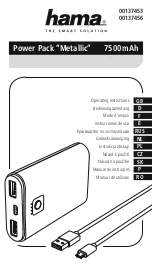
KLP-HV 031308
2-13
2.7.7.1
LOAD SHARING
When operating two or more power supplies in parallel, either for capacity or redundancy, it is
desirable to distribute the load equally among all of the power supplies in order to improve per-
formance, reduce stress and increase reliability. KLP power supplies incorporate active circuitry
which forces multiple power supplies wired in parallel to share load current, both in voltage- and
current-mode regulation. The KLP employs a single wire connection between paralleled power
supplies, forming a master-slave relationship as follows: the highest voltage unit becomes the
master, and all of the remaining units are slaved to it via the current share signal (CS, available
at the rear panel terminal A3TB3, Figure 2-2), which boosts the slave outputs in order to
increase load share. A maximum boost limit prevents the slave units from following a defective
master into an overvoltage condition, or from creating a load hazard if either the slave itself or
the load sharing system is defective.
When implementing load sharing, the user must ensure that all power supplies are attempting to
regulate to the same voltage at the same location, and must minimize the possibility of load
share signal corruption; the power supplies should, as nearly as possible, emulate a single large
power supply. To this end, the following rules apply:
a. If possible, remote error sensing should be employed, with all error sensing connections ter-
minated at the same physical point, and as close to the power supplies as possible; if local
error sensing is required, power lead voltage drops must be minimized. Provide local noise
decoupling capacitors across all sense wire termination points.
b. The power supplies should be located as near to each other as possible, with power termina-
tions bussed together using adequately sized interconnections; the power supply/load inter-
connections should be distributed evenly along the power supply output interconnection bus-
ses. This is especially important in high-current systems employing several power supply
modules in parallel, where voltage drops in the interface connections can be significant in
comparison to the load share signal voltage and introduce both d-c and a-c errors.
c. All power supply output voltages should be adjusted as closely as possible, and in any case
within a 1% error band. Additionally, the current limit setpoints should be identical and high
enough to support the load requirements; for (N+M) systems, this means setting the current
limits high enough to tolerate loss of M power supplies and still support the load.
d. Minimize the current share signal wire interconnection lengths to reduce risk of noise influ-
ence.
2.7.8
MASTER/SLAVE CONFIGURATIONS [-1200 MODELS ONLY]
Master/slave configurations of power supply pairs can be used to allow changes to output volt-
age/current of one supply (master) to affect the output of the other (slave). Both units of a mas-
ter/slave configuration must be identical models. Master/slave control is implemented using the
RS 232 ports. After connecting the series or parallel pair (see PAR. 2.7.6 or 2.7.7, respectively),
use a null modem cable, minimum length 0.5 foot, DB9F-DB9F, to connect the RS 232 ports of
both power supplies. Then refer to PAR. 3.2.11 to complete the setup of each power supply in
the master/slave configuration.
Summary of Contents for KLP 10-150-1.2K
Page 2: ......
Page 6: ......
Page 12: ...vi KLP031308 FIGURE 1 1 KLP SERIES POWER SUPPLY...
Page 19: ...KLP 031308 1 7 FIGURE 1 3 KLP SERIES POWER SUPPLY MECHANICAL OUTLINE DRAWING SHEET 2 OF 2...
Page 24: ......
Page 27: ...KLP HV 031308 2 3 FIGURE 2 2 KLP SERIES REAR PANEL SWITCH AND CONNECTORS...
Page 40: ......
















































